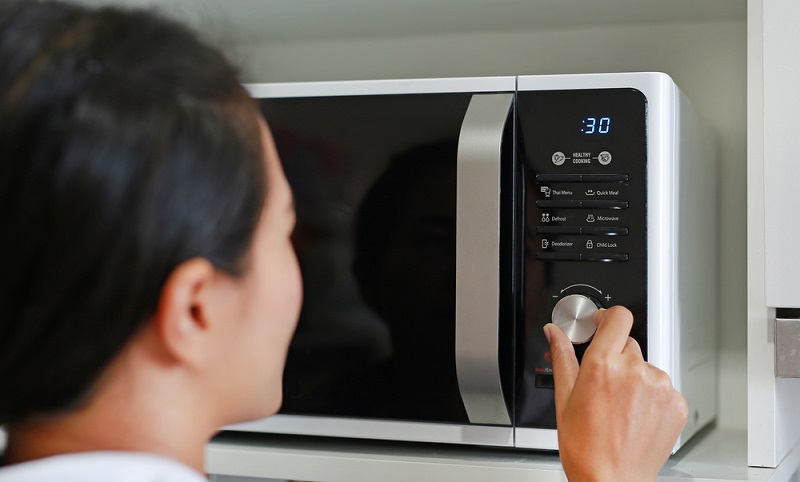
Is It Safe to Stand in Front of Microwave Ovens?
Here's what you need to know about microwave oven radiation.

Microwave ovens have been a kitchen staple for decades, allowing you to cook everything from frozen vegetables to packaged meals in minutes. But while you zap your food, you may wonder how close you can safely stand next to a microwave, and whether any radiation could escape from the device and potentially harm you.
Do you really need to worry about this? The short answer is, not really. Injuries from microwave radiation are very rare, according to the U.S. Food and Drug Administration. However, there are certain precautions you can take to keep yourself safe when using a microwave oven.
Microwaves are a type of electromagnetic radiation, or waves of energy that move through space, according to the FDA. Electromagnetic radiation takes different forms, including radio waves, visible light, X-rays and gamma-rays.
Related: Why Does Metal Spark in the Microwave?
Microwaves, like radio waves, are a type of of "non-ionizing radiation," meaning they don't have enough energy to knock electrons out of atoms, the FDA says. Microwaves are therefore not known to damage DNA inside cells, according to the American Cancer Society.
In contrast, X-rays and gamma-rays are classified as "ionizing radiation," a type that does have enough energy to remove electrons from atoms and can damage cells and DNA.
Even though microwaves don't pose the same health risks as X-rays, that doesn't mean they are risk-free. Microwaves heat food by causing water molecules to vibrate, which produces heat. In theory, microwaves can heat body tissues in the same way they heat food, and at high levels, microwaves can cause burns and cataracts, according to the FDA. But these types of injuries are very rare and have generally occurred when people are exposed to large amounts of radiation leaking through openings in the oven, such as gaps in the seal, the FDA says.
Sign up for the Live Science daily newsletter now
Get the world’s most fascinating discoveries delivered straight to your inbox.
What's more, the FDA requires microwaves to be designed in a certain way to prevent these types of radiation leaks. For example, the FDA requires that microwave ovens have two interlock systems that halt the production of microwaves the moment the door is opened. And the agency requires that these ovens have a monitoring system that stops the device from operating if one of the interlock systems fail.
As a result, there is "little cause for concern" about excess microwaves leaking out from your oven, unless there is damage to the door hinge, latch or seal, the FDA says.
Mind the heat
Still, the agency recommends that you check your microwave oven carefully and do not use it if the door doesn't close properly, or if it is "bent, warped, or otherwise damaged." As an added precaution, the FDA recommends that you don't lean or stand directly against a microwave oven for long periods while it's operating.
As far as injuries from microwave ovens go, the most common way people are injured is via heat-related burns from touching hot containers or overheated foods, or being exposed to exploding liquids. The FDA recommends that people use common-sense precautions when handling hot foods and beverages cooked in microwave ovens.
The agency also warns that, when you use a microwave to heat water in a cup, there's a risk of the water becoming "superheated," which means it has heated past its boiling point. When this happens, the water does not appear to be boiling, but just a slight disturbance to the water — which can occur when touching or picking up the cup — can cause an eruption of boiling water. This can lead to skin burns or scalding injuries, particularly on the face and hands. To prevent superheated water from forming, the FDA says people should not exceed the recommended heating time for water, as indicated in the oven's instruction manual.
Indeed, it's generally a good idea to read and follow your microwave oven's instruction manual to help keep yourself safe when using it.
- 5 Things You Shouldn't Do With a Microwave Oven
- Why Does Microwave Popcorn Smell So Bad?
- Who Invented the Microwave Oven?
Originally published on Live Science.

Rachael is a Live Science contributor, and was a former channel editor and senior writer for Live Science between 2010 and 2022. She has a master's degree in journalism from New York University's Science, Health and Environmental Reporting Program. She also holds a B.S. in molecular biology and an M.S. in biology from the University of California, San Diego. Her work has appeared in Scienceline, The Washington Post and Scientific American.










